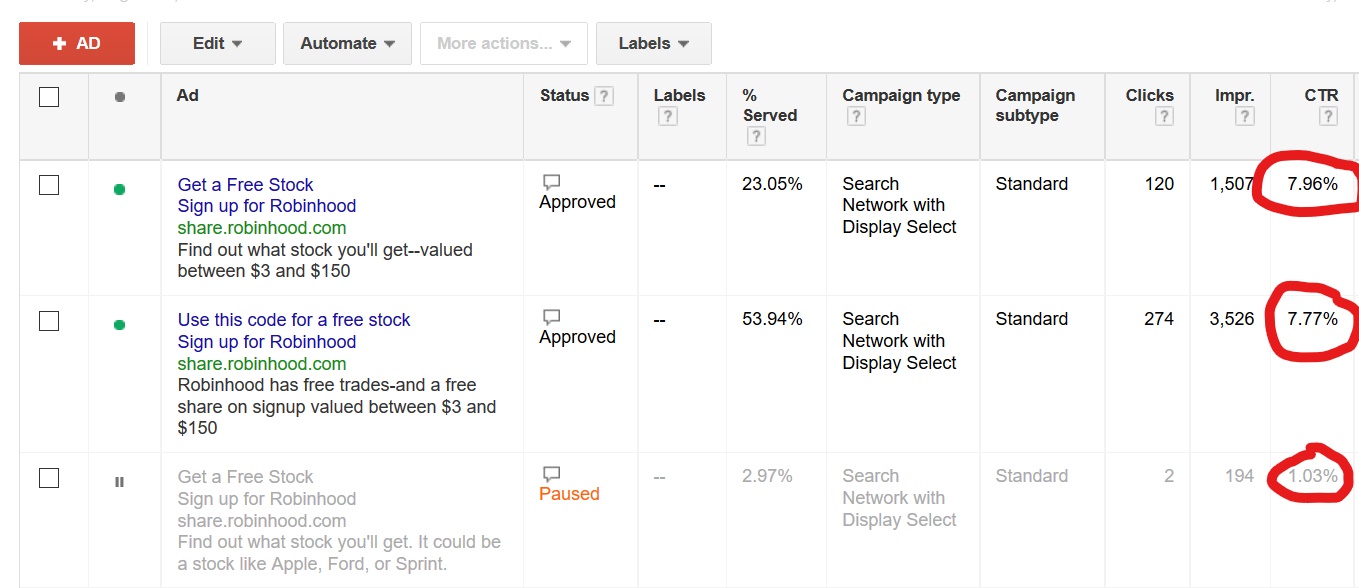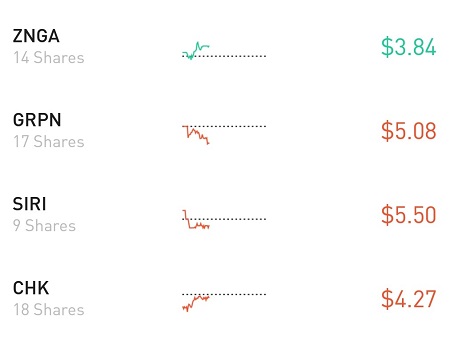Gaming Robinhood's Free Stock Referral -- Or, How to Blow $350
I blew $361.84 trying to game Robinhood’s free stock promotion.
The best way to learn is to learn by doing.
To avoid doing, I read books and articles all day. It’s ‘Productive’ procrastination. Reading is great, but until I put whatever it is I’m learning into practice I don’t truly understand.
I’ve been wanting to learn more about how google ad words work: What makes a good ad? How do I get more people to click? How should I set prices? I’ve read plenty of blogs on these subjects, but they didn’t make me a great Adsense marketer.
Enter Robinhood.
Robinhood is a stock trading app. Right now they’re running a referral promotion: if you sign up using my link, we each get a stock, randomly chosen from a pool.
Read more about Growth hacking tricks like Robinhood’s Free Stock giveaway
My friends who are interested in stocks already use Robinhood, so if I wanted to take advantage of this promotion I’d have to go to strangers. I don’t run a financial blog, so spamming a link here makes no sense. Let’s run some ads.
Max Downside: $350
When you’re trying something new, set limits on your downside. I randomly picked a limit of $350. It’s enough money to get some skin in the game–I wanted to take this experiment seriously without blowing my life savings.
If I spend money on ads and zero people click, or Robinhood bans my account, or some other unexpected event happens, I’m out $350.
Could I have taken a free online course on how to use adwords? Yes, but it would have gone in one ear and out the other. If I even finished the course.
Free online courses have an extremely low completion rate, because there’s no stakes involved. My local gym runs nutrition challenges. They used to do them for free, but when they started making participants buy a t-shirt, success rates shot up. Skin in the game.
There’s always non-cash downsides as well. If I do get some free stocks, I’ll have to do some extra work on my taxes this year. There’s also the opportunity cost of running this experiment instead of doing other useful work.
Potential Upside?
What I thought: Hella Cash as my account grows with dozens of AAPL and FB shares.
Upside Even if I fail:
- I learn how to use setup and run ads on google
- I get a better sense of how copywriting affects users
- I get real world experience where I can run some cost-benefit analysis
- I get material for a blog post
Cost of Acquisition vs. Lifetime Value
The goal of any marketing campaign is to keep your cost of acquisition lower than your lifetime value [1].
Cost of Acquisition: How much it costs to acquire a customer.
Ideally we want to minimize this.
Lifetime Value: How much money a customer brings in over time
My lifetime value for a ‘customer’ is one stock, so the average of whatever Robinhood is giving out. I just guessed $5. In a ‘real’ business a customer can continue to buy additional products you sell, but here I’m limited to one-stock.
Conversion Rate
There’s two conversion rates of interest:
- How many people who see my ad click?
- How many stocks did I receive per click?
The first will help me focus on ads with better copy. The second greatly impacts cost of acquisition.
What I did
I signed up for an Adwords account, picked keywords related to free stocks, and started writing ads.
I wrote ten versions of ads pointing to my affiliate link. The idea was to try a bunch of different copy, watch performance, and cut all but top performers.
Some of my copy was taken strait from Robinhood ads, some I wrote to emphasize value to the viewer, and some I wrote the cheesiest scammy looking copy I could think of.
Turns out the 80/20 rule is real, out of 10 ads only 2 had decent CTR:

Note how both of them emphasize value to the viewer in real numbers. My ads without hard numbers received fewer clicks.
Cost Per Click
You can set a cost per click, or let Google pick for you. At first, I let Google aim to get my ad at the top of the page. I figured putting my ad at the top of the page would get the most hits. This would turn out to be my downfall.
Clicks at the top of search results were costing me upwards of $1, and quickly depleting my budget. After a few days I realized that there was no way I’d make money spending that much per click. I drastically lowered my max cost per click and asked Google to optimize for clicks rather than position.
Results

After a week, I had spent out my budget. Results:
- 654 clicks
- Cost per click: 55 cents / click

- 58 Stocks
- $266.37
- $4.59 average LTV for each customer
I ended up only getting Robinhood’s ’low value’ stocks, if I had gotten lucky and scored a higher valued stock, it would have skewed the average higher.
Cost Benefit Analysis
Conversion Rate: 654 clicks / 58 stocks => 11 clicks / stock
Cost of Acquisition: $6.20 adspend / stock
Breakeven Cost per click: 35cents / click
Oof. I way overspent per click. My Cost of acquisition was way higher than the LTV of my ‘customers’.
Still, I only lost ~$100. I didn’t get rich beyond my wildest dreams, but $100 is not a terrible price to pay for education.
What Could I Have Done Better?
Start smaller
I blew a lot of money early on by optimizing for the top spot on google, instead of minimizing cost per click. I should have been trying to figure out the minimum I could spend to get referrals.
Actually sit down and estimate a LTV.
Robinhood listed the probability of groups of stocks, which could’ve given me a more accurate number. I had guessed $5, but after this experiment I received an average of $4.59 for each stock. With this smaller LTV, it would have been easier to see that I should spend less per click.
Check Your Upsides
While running this experiment, I found out there’s a $500 limit. It would have been prudent to look this up beforehand.
With Robinhood capping rewards to $500 worth of stocks, at most I’d only make a $150 profit. Next time you have an opportunity, check your upsides. Just because something is ’easy money’ doesn’t automatically make it worth your time.
Avoid infomania
During the experiment, I was obsessed with checking my progress. At work I place my phone in the next room to avoid distractions. Even still, in the back of my head I was always wondering, “Did I get another stock yet? Should I go check the app?” I’d interrupt work to check my phone, even though checking every 5 minutes provided me with zero actionable information.
For projects like these, schedule a time to check progress. Once a day, or even less, is enough to make good decisions without overwhelming yourself with noisy data.
Sell a product with a better LTV
Here I’m just promoting Robinhood and getting someone else a free stock – I’m acting like a middleman and not creating much value. Like all arbitrage, the more people that do it, the smaller the margins get. ‘Gaming’ promotions like this is fun, and can provide valuable lessons, but ultimately the opportunity goes away and you haven’t built an asset you can keep later. If you are able to sell a real product and provide more value for people, your return on advertising is much more likely to be worth it.
Closing Thoughts
With so many variables in advertising, there’s no wonder a good marketer can have an excellent career. Advertising today lies in the Complex Domain, where there’s no clear ‘right answer’ to any action. While the end goal is to spend less than you bring in, there’s no obvious path to get there.
Despite losing money, this was a fun project. I’ve learned a bit about using Google ad words, copywriting, and marketing.
What else could I have done better? Have you ever tried ‘gaming’ a promotion?
Let me know: @uberstuber or james@jamesstuber.com
If you enjoyed this post, try running an experiment! Here’s a list of other things I’ve tried.
Updates 10/25
This writeup made it to the front page of Hacker News. Some interesting discussions ensued.

@DuncanSBX from Strong Coffee Marketing points out that I was using ‘display select’ for my ad campaign. This means my ads not only appeared on search pages (where I wanted them), but also on related websites and videos (where I didn’t want them). This meant I was spending more to place ads I didn’t want to buy. Thanks for the tip Duncan!
Plenty of readers wanted to know how many referrals I got from posting this article vs shares from the ad campaign. As of today I’ve received another 25 free stocks from people reading the article! I’ve basically broken even on my initial $350, which feels a lot better than losing money.
Notes:
[1]: Of course, there are exceptions to this rule: Do Things That Don’t Scale by Paul Graham
